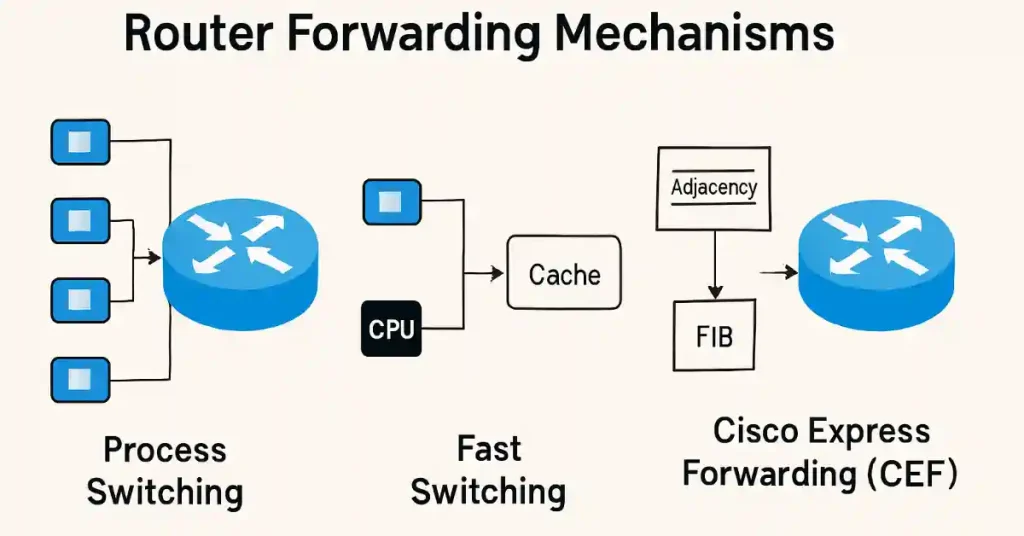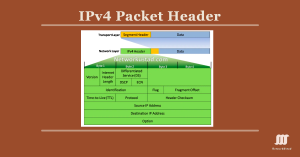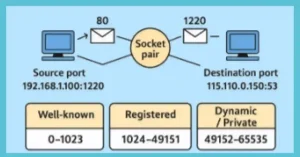Understanding Cisco Router Forwarding Mechanism is a cornerstone of networking for CCNA and CCNP students. Routers, the backbone of network connectivity, rely on efficient packet-forwarding mechanisms to direct traffic toward its destination. Cisco routers support three primary methods—Process Switching, Fast Switching, and Cisco Express Forwarding (CEF)—each with unique characteristics affecting performance, scalability, and resource usage. This article dives into these mechanisms, offering clear explanations, configuration steps, and practical insights to help you master packet forwarding for your certification exams and real-world networking tasks.
Process switching
Process switching is the most basic and resource-intensive packet-forwarding mechanism in Cisco routers. When a packet arrives at an interface, the router’s CPU processes it by performing the following steps:
- Packet Reception: The packet is received and stored in the router’s system memory.
- Routing Table Lookup: The CPU performs a full lookup in the routing table to determine the destination interface and next-hop address.
- Frame Encapsulation: The packet is encapsulated in the appropriate data link layer frame for the outgoing interface.
- Packet Forwarding: The packet is sent out via the exit interface.
Key Characteristics
- High CPU Usage: Each packet requires individual processing, leading to significant CPU overhead, especially under high traffic loads.
- Memory Impact: Packets are stored in system memory, which can strain resources in low-memory devices.
- Use Case: Rarely used in modern networks due to its inefficiency, but useful for troubleshooting or specific scenarios requiring per-packet processing.
Example Scenario
Imagine a small branch office router receiving 100 packets per second, all destined for the same subnet. With process switching, the CPU processes each packet individually, leading to potential delays and high CPU utilization. This makes process switching unsuitable for high-traffic environments.
Configuration
To enable process switching on an interface:
Router> enable
Router# configure terminal
Router(config)# interface FastEthernet0/0
Router(config-if)# no ip route-cache
Verification
Check if process switching is enabled:
Router# show ip interface FastEthernet0/0 | include route-cache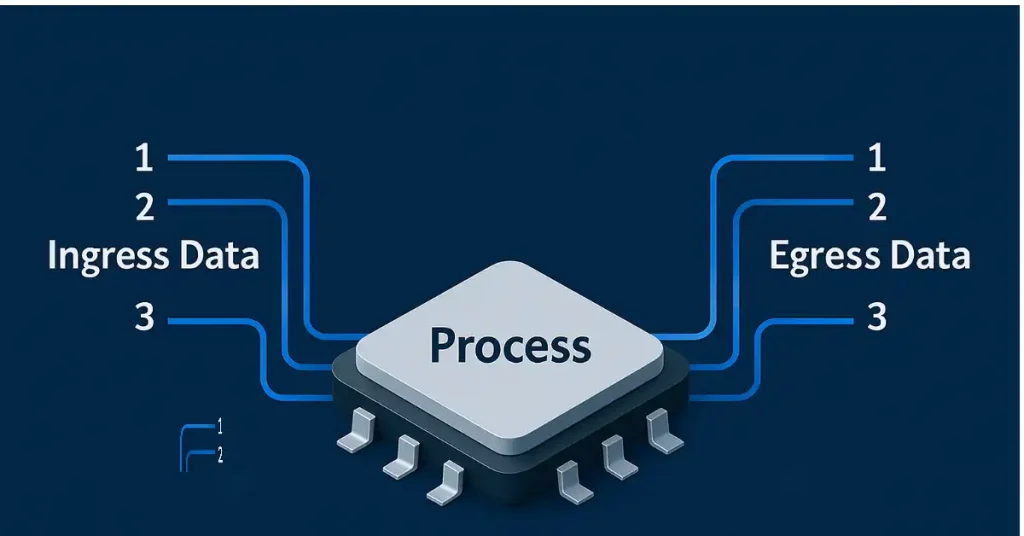
Figures 1 illustrate the packet forwarding mechanisms of a processed switch. Assume that a traffic flow consists of three packets, and all packets are for the same destination. As shown in the Figure, with process switching, each packet must be processed by the CPU one by one.
Fast switching
Fast switching improves upon process switching by using a cache to store next-hop information, reducing CPU involvement for subsequent packets to the same destination. When a packet arrives:
- Initial Processing: The first packet to a destination is process-switched, and the CPU performs a routing table lookup.
- Cache Creation: The forwarding information (next-hop address, exit interface, and Layer 2 details) is stored in the fast-switching cache.
- Subsequent Packets: Additional packets to the same destination use the cached information, bypassing full routing table lookups.
Key Characteristics
- Improved Speed: Significantly faster than process switching due to cache utilization.
- Limitations: Cache invalidation occurs when the routing table changes (e.g., route flaps), requiring new process-switched lookups.
- Use Case: Suitable for small to medium networks with stable routing tables, but less efficient for dynamic environments like Internet backbones.
Configuration
To enable fast switching on an interface:
Router> enable
Router# configure terminal
Router(config)# interface FastEthernet0/0
Router(config-if)# ip route-cache
Router(config)# interface FastEthernet0/1
Router(config-if)# ip route-cache
Verification
Verify fast switching is enabled and view the cache:
Router# show ip interface FastEthernet0/0 | include route-cache
Router# show ip cache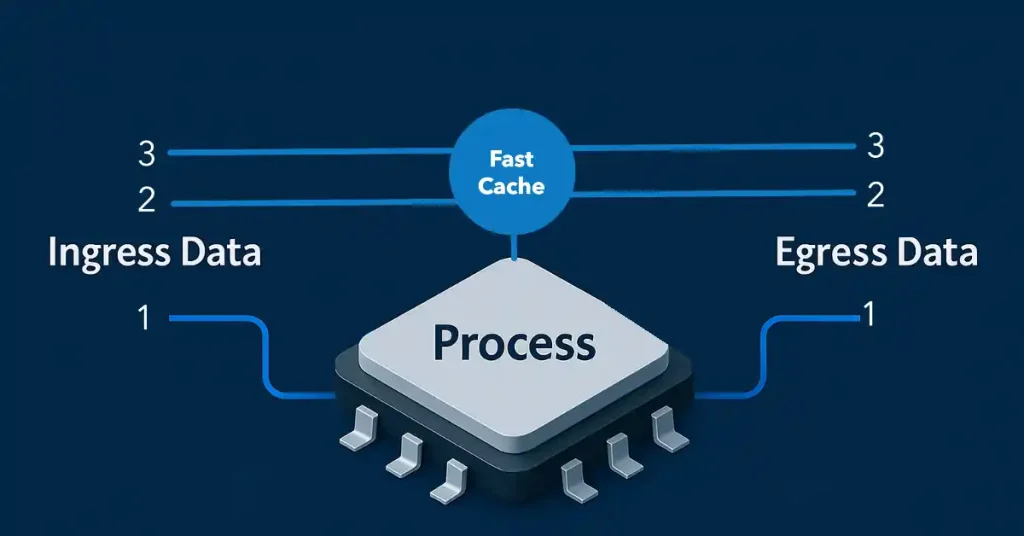
Figure 2 illustrates the fast switching, where only the first packet of a flow is process-switched and then stored in the fast-switching cache. The next two packets are quickly processed based on the information in the fast-switching cache.
Practical Note
Fast switching is less common in modern Cisco devices, as CEF is the default. However, understanding fast switching is crucial for legacy systems and CCNA/CCNP exams.
Cisco Express Forwarding (CEF)
Cisco Express Forwarding (CEF) is the most advanced and efficient packet-forwarding mechanism in Cisco routers. Unlike process or fast switching, CEF builds its cache proactively, before packets arrive, making it ideal for high-performance networks.
How CEF Works
CEF uses two key data structures:
- Forwarding Information Base (FIB): A mirror of the routing table, optimized for fast lookups. It contains pre-computed next-hop information, including IP addresses, interfaces, and Layer 2 headers.
- Adjacency Table: Stores Layer 2 information (e.g., MAC addresses) for directly connected devices, enabling quick frame encapsulation.
Key Characteristics
- Proactive Cache Building: CEF constructs the FIB and adjacency table when the network topology stabilizes, not when packets arrive.
- Scalability: Handles large routing tables and high traffic volumes, making it ideal for enterprise and service provider networks.
- Use Case: Default in modern Cisco IOS versions (e.g., IOS-XE) and critical for SD-WAN, MPLS, and data center environments.
Configuration
To enable CEF on an interface (though it’s enabled globally by default in modern IOS):
Router> enable
Router# configure terminal
Router(config)# interface FastEthernet0/0
Router(config-if)# ip route-cache cef
Router(config)# interface FastEthernet0/1
Router(config-if)# ip route-cache cef
Verification
Verify CEF configuration and view FIB/adjacency tables:
Router# show ip cef
Router# show adjacency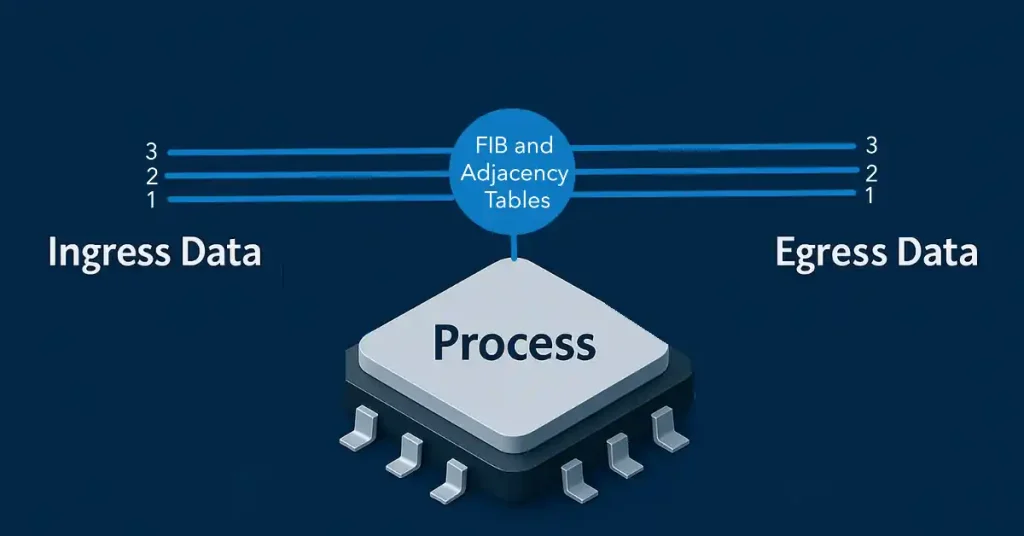
Figure 3, illustrates the CEF process where the CEF builds the FIB and adjacency tables after the network has converged and processed all packets quickly.
Modern Context
CEF is the backbone of modern Cisco routers and switches, supporting technologies like SD-WAN and MPLS. Its ability to handle complex routing scenarios makes it essential for CCNP-level studies and real-world deployments.
Comparison of Packet Forwarding Mechanisms
| Feature | Process Switching | Fast Switching | Cisco Express Forwarding (CEF) |
|---|---|---|---|
| Speed | Slowest | Moderate | Fastest |
| CPU Usage | High | Moderate | Low |
| Cache Mechanism | None | Reactive (post-first packet) | Proactive (pre-built) |
| Scalability | Poor | Moderate | Excellent |
| Use Case | Troubleshooting | Legacy networks | Modern enterprise/service provider |
| Configuration Command | no ip route-cache | ip route-cache | ip route-cache cef |
Troubleshooting Packet Forwarding Issues
Common Issues and Solutions
- High CPU Usage (Process Switching):
- Symptoms: Router performance degrades under load.
- Solution: Verify if process switching is enabled (
show ip interface | include route-cache). Enable CEF withip route-cache cef.
- Cache Invalidation (Fast Switching):
- Symptoms: Intermittent packet drops due to routing table changes.
- Solution: Check routing table stability (
show ip route). Consider switching to CEF for dynamic environments.
- CEF Not Enabled:
- Symptoms: Unexpected performance issues in high-traffic networks.
- Solution: Confirm CEF is enabled globally (
show ip cef) and on interfaces (show ip interface | include cef).
Verification Commands
show processes cpu: Monitor CPU usage.show ip cache: View fast-switching cache.show ip cef: Inspect FIB entries.show adjacency: Verify adjacency table.
Conclusion – Router Forwarding Mechanism
Mastering Cisco’s packet-forwarding mechanisms—Process Switching, Fast Switching, and Cisco Express Forwarding (CEF)—is essential for CCNA and CCNP students aiming to excel in their certification exams and real-world networking roles. Process switching, while foundational, is resource-intensive and rarely used in modern networks. Fast switching offers improved performance through caching but falls short in dynamic environments. CEF, the default in contemporary Cisco devices, delivers unparalleled speed and scalability, making it the cornerstone of enterprise and service provider networks.
Understanding these mechanisms not only prepares you for exam questions but also equips you to optimize router performance and troubleshoot issues effectively. By practicing configurations in tools like Packet Tracer or GNS3 and leveraging commands like show ip cef and show ip cache, you can gain hands-on expertise. Continue exploring Cisco’s documentation and lab exercises to deepen your knowledge and stay ahead in your networking journey.
FAQs
What is the difference between process switching and CEF?
Process switching involves CPU processing for each packet, making it slow and resource-intensive. CEF pre-builds a Forwarding Information Base (FIB) and adjacency table, enabling fast, CPU-independent forwarding.
Why is CEF the default in modern Cisco routers?
CEF offers superior performance and scalability, handling large routing tables and high traffic volumes efficiently, making it ideal for modern enterprise and service provider networks.
Can I use process switching in production networks?
Process switching is generally not recommended for production due to its high CPU usage. It’s primarily used for troubleshooting or in low-traffic scenarios.
How do I verify if CEF is enabled on my router?
Use the commands show ip cef to check the FIB and show ip interface | include cef to verify CEF is enabled on specific interfaces.
Is fast switching still relevant for CCNA/CCNP exams?
Yes, understanding fast switching is important for legacy systems and exam questions, though CEF is the focus in modern networks.

